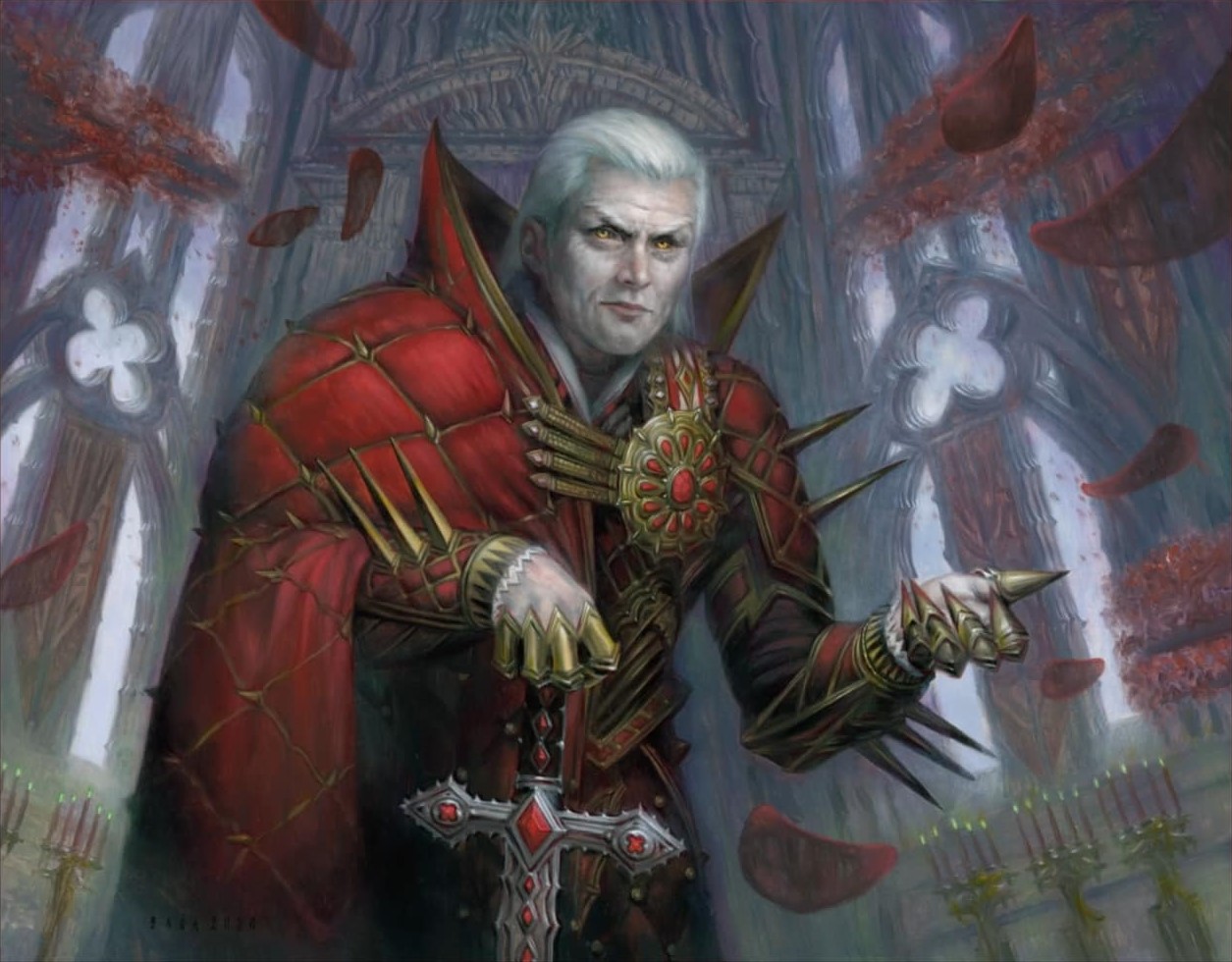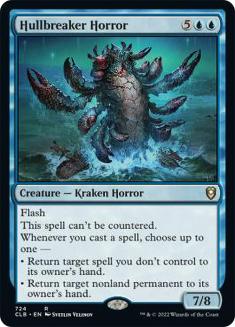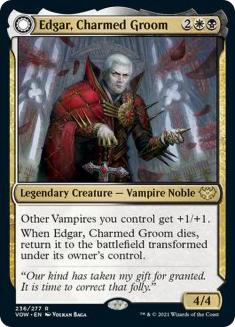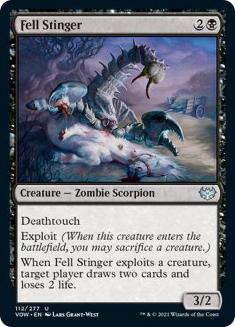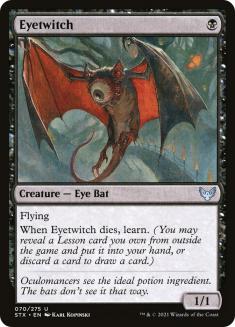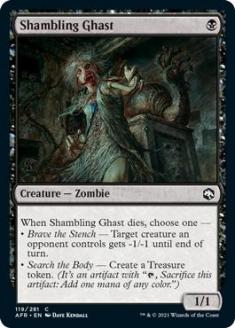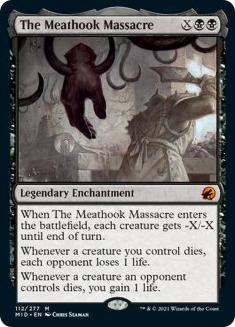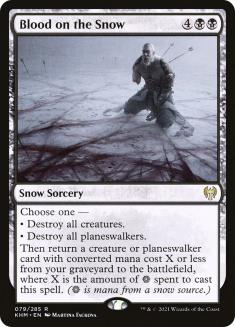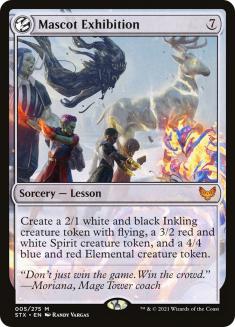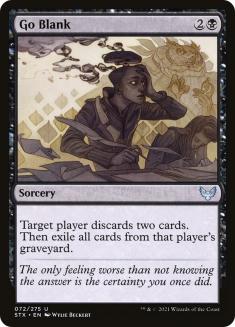Midrange strategies have gotten battered over the last few months, with Alrund’s Epiphany being the primary offender. That card is so difficult to interact with and so powerful that it completely invalidated midrange as an archetype. Since midrange decks don’t win quickly and usually interact by killing creatures or playing discard spells, it stands to reason that the blue decks would adopt Alrund’s Epiphany and dodge both of those pretty easily.
Fast forward to the format devolving into Aggro VS Alrund’s Epiphany, and you basically have a snapshot of the last few weeks of tournaments. Mono-Green Aggro❄ and Mono-White Aggro❄ were both at the top of the curve, and the Izzet decks were trying to fight them while simultaneously trying to beat each other. It led to a lot of in-fighting among Izzet pilots, and caused the archetype to branch in a few different directions. Copying Alrund’s Epiphany with Galvanic Iteration was the way to beat mirrors, but that version often left you feeling inadequate against creature rushes.
The release of Innistrad: Crimson Vow was supposed to shake things up a bit, but what we’re mostly seeing is those three strategies getting a bit of a boost. A few other decks popped up this past weekend, but three major tournaments yielded predictable results. The rise of aggro is upon us now, which means it was no surprise when a mopey midrange deck ended up winning one of the three events. Orzhov Midrange❄ by ManaFox won the Crokeyz Crimson Vow tournament, even though Izzet was still looking good. So what happened?
Mono-White Aggro❄ is weak to sweepers and cheap removal. Their whole gameplan revolves around sticking three to five threats in the early turns and riding them to victory because they’re cheaper than the opposing removal. While they’re soft to Cinderclasm and such, you can also profitably interact with them by casting Shambling Ghast and Eyetwitch. These cheap defensive creatures can trade with many of their threats, gaining a point of advantage along the way. When you’re interacting on all three mediums, Mono-White Aggro❄ will falter.
Mono-Green Aggro❄ has fallen off a bit, but they were also weak to Blood on the Snow. Without one-drops, they can’t close games that quickly. Their best card in the matchup is Esika’s Chariot, but everything else gets dunked on by traditional removal and sweepers. Wrenn and Seven was great in this type of matchup, but has since lost favor due to high numbers of Fading Hope running around.
Control also took on a new face.
Bryan Gottlieb posted some heat on Twitter about the new finisher, and it seemingly caught a lot of people’s attention.
I love this initial list. It has everything you could want in a control deck: card advantage, removal, cheeky singletons, and a nearly unbeatable top-end threat. I will admit that my first reading of Hullbreaker Horror did not convince me that it was good. That was likely due to reading the ability as “enters the battlefield” as opposed to “whenever you cast a spell.” Like most seven-mana blue creatures with flash, I just expected it to function like Torrential Gearhulk. I was surprised when I first saw it in action. What a disgusting creature. An absolute menace.
However, Hullbreaker Horror being the top-end threat as opposed to Alrund’s Epiphany means we can interact with it. Removal spells like Vanishing Verse and Infernal Grasp can kill it before the opponent gets to untap with it. Because there aren’t many expensive flash spells in Standard, you can usually guess when your opponent is about to get Kraken. If that’s the case, just hold up mana. They don’t play too many copies of Negate in the maindeck, and post-sideboard your discard spells should help prevent your opponent from protecting it.
With that said, if your opponent ever sticks a Hullbreaker Horror and you can’t kill them immediately, the game is over. Each spell cast acting as a Divide by Zero is unreal. I can’t really describe to you what happens when Hullbreaker Horror comes down other than “nothing you do matters anymore.”
Hullbreaker Horror is the sea, and she will swallow you whole.
Regardless, the point I’m trying to make is that a Hullbreaker Horror is still easier for Orzhov Midrange❄ to beat than chaining Alrund’s Epiphany. A permanent that can be targeted is easier to kill than a spell that can only be discarded or interacted with while on the stack. Since both cost seven mana, it’s unlikely that a control deck will want to play both. As long as people are playing Hullbreaker Horror over Alrund’s Epiphany, Orzhov Midrange❄ has a chance against them. Coupled with the natural advantage over traditional aggro strategies, Orzhov Midrange❄ starts to sound like a reasonable strategy.
School of Rock
Smaller metagames often boil down to three distinct archetypes: aggro beats control, control beats midrange, and midrange beats aggro. That isn’t always the case, but starting there is often the best because it’s the most common. You’ll often hear content creators call this a “Rock-Paper-Scissors” metagame, referring to each archetype able to handily defeat one while falling regularly to the other. That’s balance. That’s healthy.
Sometimes one of those decks becomes so far and away better than the other two that it starts to break the normal structure. This isn’t always a bad thing, but it gets a little weird when one of the three major archetypes just ceases to exist. Alrund’s Epiphany led to a complete dismantling of midrange, but all that’s about to change. Mono-White Aggro❄ is now too strong for Izzet to compete with outside of drastic changes, which in turn will cause ripple effects.
Here’s the Orzhov Midrange❄ list that won the Crokeyz Crimson Vow tournament:
Creatures (18)
Planeswalkers (4)
Lands (24)
Spells (14)

Turns out immortality has its benefits. When your opponent uses Infernal Grasp to kill your Edgar, Charmed Groom, it just goes into hibernation, returning after some time to regenerate. During those regeneration turns, Edgar Markov’s Coffin produces some Vampires to keep your opponent from running away with the game. We’ve seen cards like this in the past but they’re somewhat rare. The biggest draw for Edgar, Charmed Groom is that it doesn’t cost mana after the initial investment.
I’ve been calling it Bat’erblossom, as Edgar Markov’s Coffin continues to generate bodies even after you “deal” with it. Outside of sending it to exile, you will have trouble killing Edgar permanently. While the back side is just “make a few tokens over a few turns,” the fact that it essentially survives removal and even comes back after a small wait is just so cool. Oh, and did I mention that Edgar’s front half pumps the Vampire tokens from the back half? That might not sound too ridiculous until you realize that they also have lifelink, which makes racing a bit difficult. At its core, this card reminds me a lot of Legion’s Landing. It seems innocuous, but over time it just runs away with the game.
I love the fact that you can cast a second Edgar, Charmed Groom and have it immediately transform into Edgar Markov’s Coffin. It’s rare that duplicate legendary permanents can be played for value, but this little interaction is pretty sweet. The tokens created from the Coffin will be pumped by the Edgar on the battlefield. Obviously if your opponent kills your front-facing Edgar, it will transform into a duplicate Coffin and one will be lost, but that’s a small price to pay for having your legendary spell work together in duplicates.
Against aggro decks, Edgar, Charmed Groom will look a little weak on the front side. You should be looking to trade it immediately for their largest creature. If you can do that, the back half will offer some bodies to sacrifice to various spells, but it will also give you lifelink chump blockers for days. Against other midrange decks, you’ll have a threat that will be difficult to remove permanently. Destroying the Coffin or exiling Edgar will be their only real route to victory. Against control, both halves should be somewhat taxing, but their bounce spells will be rather scary. As usual, Divide by Zero and other counterspells are absolutely massive against midrange.
Fell Stinger is one of my favorite cards from the new set. It’s one of the most versatile creatures I’ve ever seen. At face value, you can use it like Read the Bones. When you have another piece of fodder, you can sacrifice that and keep a deathtouch creature around. As the game comes to a close, a Fell Stinger can target your opponent, dealing the last two points of damage. That’s a lot of text on a three-mana creature!
Exploit is one of my favorite abilities of all time, because the creatures with the ability can choose to sacrifice themselves. That means those creatures can essentially act as spells themselves, much like the evoke Elementals from Lorwyn. They don’t care what body is sacrificed, but it’s up to you to figure out how to get the most value from your exploit ability.
These two creatures are your fodder for all manner of sacrifice effects. Fell Stinger is just another great card added to the pile, but luckily we don’t even have to sacrifice these creatures to get their value. If they trade with an opposing creature, you still get their trigger. If your opponent kills it, you still get the trigger.
These two aren’t actually all that aggressive, so they don’t shine against control, but they are cheap. Any attempt by your opponent to interact with them will result in you getting something for your trouble. Shambling Ghast can create a Treasure to ramp into your more expensive stuff, and does exactly that when there are no targets for the -1/-1 ability. That Treasure puts you a full turn ahead of your opponent sometimes, which means your Lolth, Spider Queen or Edgar, Charmed Groom will enter the fray faster than it ought.
The Meathook Massacre hasn’t seen as much play in the new Standard format as I would have liked, but the card itself is quite strong against Mono-White Aggro❄. For three mana, you can often sweep up their entire first wave. We’re also a deck that can easily utilize the triggers from The Meathook Massacre, making it so much more than a simple sweeper.
It isn’t great against control, but The Meathook Massacre can act similarly to Blood Artist in a pinch. Gaining life against a control opponent isn’t a big deal, but having all your little creatures deal them a point of damage when they die is reasonable. Against the other decks in the format, The Massacre is a sweeper, life generator, and damage dealer. It quite simply does it all.
The other sweeper in the deck is Blood on the Snow, a midrange slapper that clears whatever ails you while bringing back your best dead threat. It’s much slower than The Meathook Massacre, and less versatile overall, but the kill plus resurrect in the same turn provides the caster with an effect that’s quite rare. Sweepers are common in Magic, but a card that clears and then presents some type of threat afterwards in one tight package is ludicrous.
Blood on the Snow offers the midrange decks a huge payoff for the low, low price of “not playing Shattered Sanctum.” You need to play Snow-Covered lands for this to work, but it’s absolutely worth it. On top of everything, you even get to play Faceless Haven, one of the most powerful creature-lands since Mutavault.
Learning About the Sideboard
The Izzet decks playing Divide by Zero for a Lesson package can get away with only playing two or three of them in the sideboard. With both Eyetwitch and Professor of Symbology, it would be wise to play a few more. This build puts an emphasis on versatility via Lesson rather than having a fully functional sideboard, and it helps you out in a lot of sticky situations.
I’m all for constricting any sort of tutor package. I think most people have one or two more of those types of spells in their sideboard than they should, but it’s far less detrimental here because we can’t actually draw the weak spells from our deck! Tutor packages have a fail rate of “drawing the card you put in the tutor package.” Lesson spells solve that problem through the function of deckbuilding.
This is a pretty awesome payoff card for something as trivial as Eyetwitch. Having your early utility creatures “discover” big spells in the late-game is absurd. When it comes to the early turns, you can find Environmental Sciences to smooth your draw. Even Necrotic Fumes is decent at taking care of an annoying creature. This deck will regularly have an extra body lying around that isn’t doing much other than participating. Mascot Exhibition is something else entirely.
Seven mana is a lot for a spell, but that cost is usually restrictive because it means you’ll draw that card in the first few turns sometimes and it won’t do anything. Lessons get around this because you don’t have to draw them, but you also get to find the right one for the right situation. If the game is going pretty long, Mascot Exhibition provides you with so much power for such a small investment of resources. A deck like this will have mana in spades because the entire design is to elongate the game. The fact that one of your primary win conditions is this powerful yet doesn’t suffer from traditional woes of expensive cards is spectacular.
This is my favorite sideboard card of the bunch because it’s actually a beating against control. Taking two cards from their hand isn’t all that impressive. Exiling their graveyard as a single effect is rather weak. However, when you combine the two, you start to see something a little more magical.
The current control decks all revolve around Lier, Disciple of the Drowned. This payoff requires the use of the graveyard, so anything that can restrict that zone without costing a full card itself is somewhat desirable. Go Blank takes two of their precious resources from hand and exiles their entire graveyard, often turning Lier from “unbeatable” to “annoyance.” It has impressed me more than virtually any other sideboard card in the past few months, as the effect it has on the game doesn’t read as important as what it actually does.
Go Blank is excellent, but I would be doing you a disservice if I didn’t tell you how important it is to have multiple ways to interact with your opponent’s hand. Brad Nelson is famous for building midrange decks with a somewhat transformational sideboard to beat control. He’s always been about killing creatures in the first game, and having a ton of discard when your opponent shows up without any. Duress is tried and true, handling most of the threats from the opposing control strategies.
Final Thoughts
The introduction of Edgar, Charmed Groom to the mix has drastically altered the gameplay patterns of this deck. When it dies, it doesn’t actually die, and the back half generates bodies necessary for fueling your engine cards. Edgar is a threat that dodges all your own sweepers effectively, and is starting to remind me a lot of Nether Spirit. The effect it has on the game isn’t exactly overwhelming on either side, but the raw endurance of the card means it will be factor throughout the rest of the game unless drastic measures are taken to prevent it.
You’re more aggressive when you need to be, and more controlling when it counts. Your removal spells have gained some traction against control thanks to Hullbreaker Horror, and a format flush with aggro means your Plan A is on point. The white splash gives you one of the best removal spells in the format in the form of Vanishing Verse. With everyone playing monocolored decks, Vanishing Verse starts to look outrageous.
If Izzet Control goes full blown “Taking Turns” with three or four Galvanic Iteration, I don’t think we can win very easily. Sideboard games can be won through a flurry of discard effects and some cheeky pressure, but I wouldn’t count on it getting the job done. As people move more toward Dragons and Hullbreaker Horror, they’re giving us the ability to interact with them on our terms. We can kill creatures. We can’t kill seven-mana sorceries.
I was expecting some different results from this past weekend, but three large tournaments have given roughly the same results. Outside of a few outliers, including this Orzhov Midrange❄ deck, Mono-White Aggro❄ is the deck to beat. Everyone else is playing from behind, but that doesn’t mean the deck is unbeatable. In fact, different decks won all three tournaments. Orzhov Midrange❄ seems to be in a favorable position against Mono-White Aggro❄, so I think right here is a great place to start.

